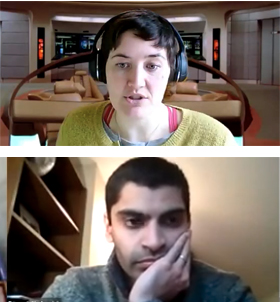
Reducing NHS waiting lists in the wake of COVID
In the depth of the pandemic, in February 2021, the Newton Gateway to Mathematics organised a fascinating event. Bringing together mathematicians and clinicians, their Virtual Study Group explored how ever-growing NHS waiting lists could be reduced, using cardiovascular disease as an example. We reported on the event at the time in a podcast and have now checked back with the Newton Gateway to see what the outcomes were — and it turns out that a useful tool for clinicians to use on the ground is in the making.
The problem
The workshop highlighted the fact that the pandemic has led to bad health outcomes in more than one way. While people have been getting sick with the virus, other conditions have remained untreated, and NHS waiting lists are growing as a result.

Heart disease is a major cause of death in the UK.
Heart conditions are a case in point. Cardiovascular disease is the leading cause of death for men in the UK and second most for women. Over the course of the COVID-19 pandemic elective cardiac procedures and outpatient consultations have been postponed and many appointments have not yet been rescheduled. In addition, those who were suffering from heart conditions did not see their GP or come to hospital — either because they did not want to impact further on NHS resources, or through concern of being exposed to the virus.
"Given that the prognoses for [cardiovascular] conditions can be quite poor, we know that unless we make some changes to the way we provide healthcare, patients individually will come to harm," said Ramesh Nadarajah, BHF clinical research fellow at the Institute of Cardiovascular and Metabolic Medicine at the University of Leeds and a Cardiology Speciality Registrar.
Effective strategies for clearing the backlog are urgently needed. And, perhaps surprisingly, mathematics can help in this context: mathematical models can help predict demand on healthcare services we can expect, they can simulate the performance of different strategies for clearing the backlog, and predict how these strategies respond to competing pressures, including future waves of COVID-19.
The three-day virtual study group called Modelling solutions to the impact of COVID-19 on cardiovascular waiting lists was convened by the Newton Gateway in February 2021 on behalf of the Virtual Forum for Knowledge Exchange in the Mathematical Sciences (V-KEMS). It brought together clinicians and mathematicians to explore if and how mathematical models could be used to provide insights and solutions to the problem of prolonged waiting lists for cardiovascular conditions.
"It was amazing to see how operational research, applied maths, and data science communities came together to respond to the urgent challenges brought by clinicians, ultimately to help save lives," said Alan Champneys, a mathematician from the University of Bristol who took part in the event.
The challenges
The overarching aim of the Virtual Study Group was to understand the time it would take to clear the backlog based on pre-pandemic as well as current (February 2021) conditions, and to explore new solutions to improve the effectiveness of the service, and their impact on the backlog.
To do this, clinicians presented three specific areas to be explored:
- The general state of the delivery of both elective cardiovascular procedures and outpatient consultations. These were to be explored at national as well as regional or local (single NHS Trust) levels.
- An example cardiovascular procedure, called aortic stenosis, for which missed early intervention can lead to death over the course of one or two years. For this condition surgery can potentially be replaced by an alternative procedure and there is a well-defined data set.
- Another example cardiovascular condition, called chronic heart failure. This is really a complex group of degenerative conditions for which treatment regimens are less well-defined. Here missed appointments may impact care to an extent that will require resources to be managed differently.
The activities
The virtual study group, comprising 40 clinicians and modellers, started off with clinicians introducing mathematicians to the relevant cardiovascular conditions and NHS pathways and presenting the challenges to be explored. Three subgroups then formed to tackle the challenges in brainstorming sessions over the remaining time of the event.
See here for all our coverage of the COVID-19 pandemic.
Interaction and communication were key to the success of the Virtual Study Group: both between clinicians and modellers to provide crucial understanding of medical as well as organisational issues, and between the mathematicians themselves whose varying skill sets and areas of expertise provided a broad base from which to address the challenges. On the final day, the subgroups presented their results and the group as a whole decided on the next steps to be taken.
"It's an intense process," said Jessica Enright from the University of Glasgow, who participated in the brainstorming. "We have this principle called 'mutually assured ignorance' which accepts that we are all brand new to the question. But by the end of the second day you realise, wow, we have done quite a lot of work here, we have done some valuable things."
The impacts

Mathematicians Jessica Enright and clinicians Ramesh Nadarajah were part of the Virtual Study Group.
Over the course of the study group, some of the challenges clinicians had described as "seemingly insurmountable" were converted into problems that could be tackled mathematically.
Despite the short duration of the event, the mathematicians found modelling approaches for all three challenges that can be refined and extended to provide useful solutions. In the case of assessing the overarching state of waiting lists, this has involved combining and extending existing models in the light of significant gaps identified by the study group. In the case of the two example conditions, the study group developed bespoke modelling approaches. (You can find out a little more about the models in our podcast.)
Additional modelling work took place following the study group, and funding from both the Isaac Newton Institute and the University Hospitals Bristol and Weston NHS Foundation Trust has enabled mathematical sciences researchers at PhD level to develop the models further. Two research papers have been submitted to journals. Aspects of the work have been presented to the Government Operational Research Service and the NHS Digital Academy, as well as at a major research conference.
The ultimate aim is to develop a tool that can help clinicians and managers at a local level to plan care, while reducing waiting lists. To that end, researchers after the workshop have already developed a mathematical model, fitted to data obtained from NHS Digital, with help from the NHS Strategy Unit and the British Heart Foundation. This has led to a group of Computer Science MSc students at the University of Bristol being tasked with creating a prototype software tool.
"Bringing together mathematicians and domain experts to come up with practical solutions through mathematical techniques is a really good idea," said Nadarajah. "Going forward, the NHS could do with this, not just [to address] cardiovascular waiting lists, but in multiple other areas too."
You can find out more about the Virtual Study Group in our podcast and the Newton Gateway website.
This article is part of our collaboration with the Isaac Newton Institute for Mathematical Sciences (INI), an international research centre and our neighbour here on the University of Cambridge's maths campus. INI attracts leading mathematical scientists from all over the world, and is open to all. Visit www.newton.ac.uk to find out more.
